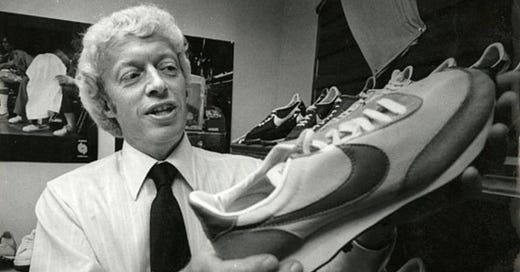Building A Forward Thinking Brand: The Nike Case Study
There are many lessons to learn from Phil Knight's journey building Nike, here is what I learnt by reading his memoir, 'Shoe Dog'...
Happy New Week,
I just finished reading ‘Shoe Dog: A Memoir by the Creator of Nike’; a book that I’d highly recommend. Nike is a forward-thinking brand and Shoe Dog explains their journey to success.
The story of Nike starts off with Blue Ribbon Sports back in 1964. Phil Knight, the founder, had an idea for a shoe company where he would sell high-quality and low-cost trainers from Japan in the US. Phil decided to travel all over the world and get as much worldly experience as possible. He also took it as an opportunity to explore the market in Japan and find a manufacturer he could do business with.
Phil managed to strike a deal with a Japanese company called Tiger shoes where he was responsible for selling their running shoes in America. Phil was a runner so he had a deep interest in running shoes. His coach, Bill Bowerman, was a well-respected running coach who had a deep obsession with creating the perfect running shoes. The two decided to go into business together.
There are many great lessons to learn from Nike’s story and Phil’s Journey. Here’s what I learnt;
You need a strong sales system
Originally starting out selling shoes from his car boot, Phil used to go to track meets to pitch to the coaches why their athletes should be wearing Blue Ribbon trainers to race. Going directly to his target audience. Phil had a huge problem with cash flow, so they decided to create the “futures'' system. This meant that retailers will commit to large and non-refundable orders, six months in advance in return for hefty discounts. This gave them longer lead times, fewer shipments, and more certainty. Therefore giving them a better chance of keeping cash balances in the bank.
Phil was focused on sales growth, to him it was either grow or die.
Build the right team and culture
When starting out Nike just focused on hiring people with “sharp minds”. People that will help the business grow and play any position necessary to win. There were many scenarios where Phil demanded a lot from his employees, making them move from one part of the US to another, forcing them to deliver in intense situations.
Phil’s managerial style wasn’t the best but one thing he did well was let his staff's natural talent shine. He said, “don't tell people how to do things, tell them what to do and let their results surprise you”. The name Nike actually came from one of his employees, Jeff Johnson, who said the name came to him in a dream. It was the name of the Greek goddess of victory.
Marketing is key
Nike did a lot of influencer/athlete marketing to generate brand awareness. Great athletes such as Jon Anderson had won the Boston Marathon wearing Nike shoes, Jimmy Conners had won Wimbledon and the U.S. Open wearing Nike shoes, Henry Rono had set four track and field records in Nikes, and members of the Boston Celtics and Los Angeles Lakers basketball teams were wearing them. This led to sales and profits doubling every year. Nike also knew that they couldn’t afford all the big current stars so they decided to target college athletes. They struck deals with college coaches and signed college teams to make all athletes on the team play in Nike trainers. This helped them get the next big stars very early on.
Be fast, be adaptable, and ready for anything
After facing problems with his Japanese manufacturer, Phil was forced to start manufacturing his own brand of shoes. This is actually what led to the creation of Nike. Phil had to find manufacturers in Mexico, Taiwan, South Korea, and Japan. If Phil didn’t plan for the inevitable he would have been left out to dry.
Love the journey more than the destination
A great lesson I learnt from Phil Knight's memoir is the importance of enjoying the journey. In the close, Phil mentioned that the feeling he felt after going public “wasn’t joy, it wasn’t relief, it was regret because he wishes he could do it all over again.” Even though that was a significant moment and indicator of their success he says “the world was the same as it was the day before, nothing had changed, least of all me. And yet I was worth $178 million.”
The Nike story is a great example of perseverance, teamwork, and constant innovation. Phil started off selling encyclopedias and couldn’t sell any to save his life but when he started his own entrepreneurial journey, he sold like his life depended on it. To Phil, Nike’s work was play, meaningful play.
“If my life was to be all work and no play, I wanted my work to be play.” Phil Knight
Shoe Dog shows the importance of documenting the journey, whether that's journaling or recording videos. Documenting the journey will help you keep track of everything you’ve done to date and all the lessons you’ve learnt along the way.
I highly recommend reading ‘Shoe Dog’ these are just a few lessons I took from it.
Have a great week



